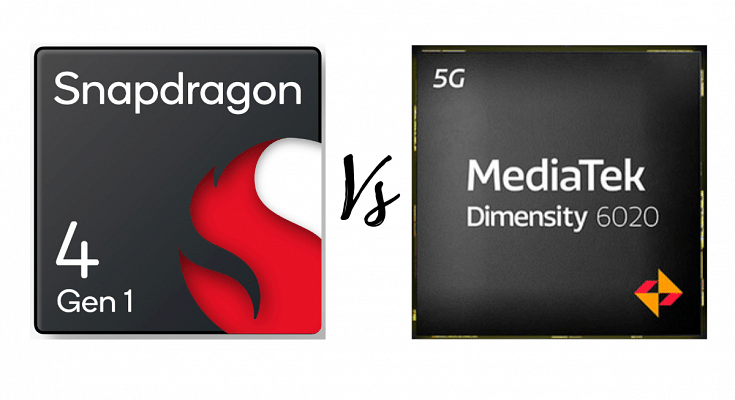Key Highlights
- Snapdragon 4 Gen 1: Faster download speeds.
- Dimensity 6020: Better multi-core performance.
- Both offer affordable 5G capabilities.
Qualcomm Snapdragon 4 Gen 1 and MediaTek Dimensity 6020 are the latest affordable 5G chipsets for Android devices. Snapdragon 4 Gen 1 offers higher clock speeds, faster download speeds, and a more powerful GPU. Dimensity 6020, on the other hand, provides better multi-core performance and higher upload speeds, making them both solid options for users looking for affordable 5G capabilities. In this comparison, we will explore the key differences and similarities between Snapdragon 4 Gen 1 and Dimensity 6020.
| Features | Qualcomm Snapdragon 4 Gen 1 | MediaTek Dimensity 6020 |
| CPU Architecture | 2x 2 GHz Cortex-A78 6x 1.8 GHz Cortex-A55 | 2x 2.2 GHz Cortex-A76 6x 2 GHz Cortex-A55 |
| Cores | 8 | 8 |
| Frequency | 2000 MHz | 2200 MHz |
| GPU name | Adreno 619 | Mali-G57 MC2 |
| Memory type | LPDDR4X | LPDDR4X |
| Storage type | UFS 2.1, UFS 2.2 | UFS 2.2 |
| Wi-Fi | 5 | 5 |
| Bluetooth | 5.2 | 5.1 |
| Info | Announced: October 2022 | Announced: March 2023 |
Also Read | Qualcomm Snapdragon 4 Gen 2 Chipset With Upgraded Performance Launched:
Qualcomm Snapdragon 4 Gen 1 Vs MediaTek Dimensity 6020: CPU Architecture

The Qualcomm Snapdragon 4 Gen 1 features an octa-core CPU with a 2x 2 GHz Cortex-A78 core and 6x 1.8 GHz Cortex-A55 cores. On the other hand, the MediaTek Dimensity 6020 also sports an octa-core CPU, but with a 2x 2.2 GHz Cortex-A76 core and 6x 2 GHz Cortex-A55 cores. Both chipsets utilize the ARMv8.2-A instruction set and offer efficient performance in their respective segments.
Qualcomm Snapdragon 4 Gen 1 Vs MediaTek Dimensity 6020: GPU Comparison

In terms of GPU performance, the Qualcomm Snapdragon 4 Gen 1 incorporates the Adreno 619, while the MediaTek Dimensity 6020 features the Mali-G57 MC2. The Adreno 619 offers a higher GPU frequency of 825 MHz compared to the Mali-G57 MC2’s 950 MHz. However, the Adreno 619 has more shading units with 128 compared to the Mali-G57 MC2’s 32. Despite these differences, both GPUs deliver satisfactory graphics capabilities for mid-range smartphones.
Also Read | MediaTek Dimensity 9200+ 5G Chipset Key Features
Qualcomm Snapdragon 4 Gen 1 Vs MediaTek Dimensity 6020: Memory, Multimedia (ISP) Comparison

Both chipsets support LPDDR4X memory type and have a memory frequency of 2133 MHz. They also offer similar memory bus configurations with 2x 16 Bit and maximum memory sizes of 8 GB for Snapdragon 4 Gen 1 and 16 GB for Dimensity 6020.
In terms of multimedia capabilities, the Snapdragon 4 Gen 1 and Dimensity 6020 support a maximum display resolution of 2520 x 1080. The Snapdragon 4 Gen 1 can handle camera resolutions up to 108MP and offers video capture at 1K 60FPS and 1080p 60FPS for playback. The Dimensity 6020, on the other hand, supports camera resolutions up to 64MP and offers video capture and playback at 2K 30FPS.
Qualcomm Snapdragon 4 Gen 1 Vs MediaTek Dimensity 6020: Final Verdict

Both chipsets offer affordable 5G capabilities for Android devices, with the Snapdragon 4 Gen 1 targeting the low-end segment and the Dimensity 6020 catering to the mid-range market.
The Snapdragon 4 Gen 1’s Cortex-A78 core provides slightly higher clock speeds, which may result in better single-core performance. The Adreno 619 GPU also offers more shading units, allowing for improved graphics rendering. Additionally, the Snapdragon 4 Gen 1 supports a faster download speed of up to 2500 Mbps compared to the Dimensity 6020’s 2770 Mbps.
On the other hand, the Dimensity 6020’s Cortex-A76 core and higher GPU frequency contribute to better multi-core performance and potentially enhanced gaming experiences. It also supports a higher upload speed of up to 1250 Mbps.
